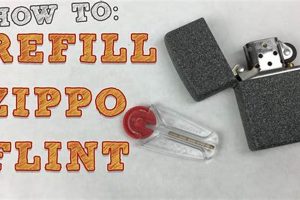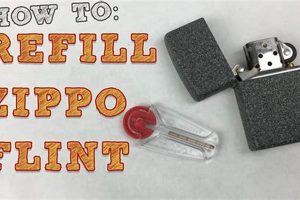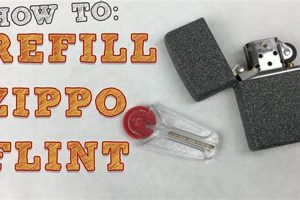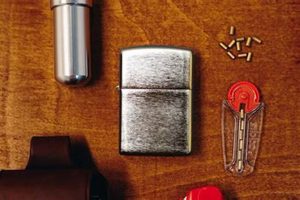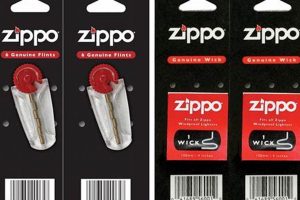A Zippo lighter’s failure to ignite can often be attributed to a jammed flint. This occurs when the flint, a small, hard cylindrical component responsible for creating sparks, becomes lodged within its housing, preventing proper contact with the striking wheel. Typically, this manifests as a lighter that spins freely but generates no spark.
A smoothly functioning flint is essential for the reliable operation of a Zippo lighter. Understanding the mechanism and potential issues associated with this small but critical component ensures the lighter remains a dependable tool. Since the introduction of the Zippo lighter in the 1930s, the basic flint and wheel mechanism has remained largely unchanged, highlighting its robust and effective design. Maintaining this mechanism is key to the longevity and usability of these iconic lighters.
The following sections will detail common causes of this malfunction, troubleshooting steps, and preventative measures to keep your lighter sparking reliably.
Troubleshooting a Jammed Flint
Several straightforward techniques can be employed to address a flint malfunction within a Zippo lighter. These methods require minimal tools and can often restore functionality quickly.
Tip 1: Inspect the Flint Spring. Ensure the spring, located beneath the flint, exerts adequate pressure. A weakened or dislodged spring can hinder proper flint engagement with the striking wheel.
Tip 2: Clear Debris. Dust, lint, or flint fragments can accumulate within the flint tube, obstructing movement. Use a small tool, such as a needle or toothpick, to carefully remove any obstructions.
Tip 3: Check Flint Alignment. The flint must be positioned correctly within its tube to contact the striking wheel. Gently adjust the flint if it appears misaligned.
Tip 4: Replace the Flint. Over time, flints wear down and require replacement. Inserting a new flint often resolves ignition issues.
Tip 5: Examine the Striking Wheel. Significant wear or damage to the striking wheel can prevent sparking. While less common than flint issues, a damaged wheel may need replacement.
Tip 6: Lubricate the Striking Wheel. A small amount of lighter fluid on the striking wheel can sometimes improve its contact with the flint. Apply sparingly to avoid flooding the lighter.
Addressing these potential issues can restore consistent sparking and ensure continued reliable operation. Regular maintenance, including flint replacement and cleaning, can prevent many of these problems.
By following these guidelines, a user can keep their Zippo lighter functioning optimally for years to come.
1. Flint Replacement
Flint replacement is directly linked to resolving a stuck flint issue in Zippo lighters. A depleted flint loses its ability to generate sparks, mimicking the symptoms of a jammed mechanism. The reduced length prevents adequate contact with the striking wheel, leading to inconsistent or absent ignition. Replacing the flint is often the first and most effective troubleshooting step. For example, a user experiencing difficulty igniting their lighter, despite spinning the wheel freely, will likely find a worn-down flint upon inspection. Installing a new flint typically rectifies the problem.
The importance of flint replacement as a maintenance procedure cannot be overstated. Regular replacement preempts ignition failures and contributes to the longevity of the lighter. While a seemingly minor component, the flint is integral to the lighter’s functionality. Neglecting this simple replacement can lead to unnecessary frustration and potentially misdiagnosing a more complex issue. Moreover, carrying spare flints ensures uninterrupted use, particularly in situations where immediate replacement isn’t feasible.
In conclusion, flint replacement addresses a primary cause of a perceived “stuck flint” scenario. Regular maintenance, including timely flint replacement, ensures reliable and consistent lighter operation. Understanding this connection simplifies troubleshooting and highlights the practical significance of this straightforward procedure within the broader context of Zippo lighter maintenance.
2. Debris Removal
Debris accumulation within the flint chamber directly contributes to flint malfunction in Zippo lighters. Minute particles, such as lint, pocket dust, or flint fragments, can obstruct the flint’s movement within its housing. This obstruction prevents the flint from making consistent contact with the striking wheel, resulting in ignition failure. A lighter exhibiting symptoms of a stuck flint may, in fact, have a perfectly functional flint impeded by debris. For instance, a lighter carried daily in a pocket will inevitably accumulate lint and dust. Over time, this debris compacts within the flint chamber, hindering flint movement and ultimately preventing spark generation.
Regular debris removal is essential for maintaining optimal lighter performance. This simple maintenance task prevents the gradual buildup of obstructing materials. Using a small tool, such as a toothpick or needle, to carefully clear the flint chamber can restore functionality without requiring flint replacement. The practical significance of this procedure lies in its preventative nature. Routine cleaning avoids the frustration of an unexpectedly non-functional lighter, particularly in situations where a replacement flint is unavailable. Consider a camping scenario where a lighter becomes clogged with debris. Understanding the impact of debris and possessing a simple cleaning tool can mean the difference between a warm fire and a cold night.
In summary, debris removal plays a critical role in addressing and preventing flint-related issues in Zippo lighters. Recognizing debris as a potential cause of ignition failure, rather than immediately assuming a faulty flint, streamlines troubleshooting. The ease and effectiveness of debris removal underscore its importance within the broader context of Zippo lighter maintenance and reliable operation.
3. Spring Tension
Adequate spring tension is fundamental to the reliable operation of a Zippo lighter’s ignition mechanism. This tension ensures consistent contact between the flint and the striking wheel, generating the necessary sparks for ignition. Insufficient tension, however, can lead to erratic sparking or complete failure to ignite, often misdiagnosed as a “stuck flint”.
- Flint Engagement:
The spring exerts upward pressure on the flint, forcing it against the striking wheel. Adequate tension ensures firm contact during wheel rotation, producing consistent sparks. Without sufficient pressure, the flint may glance off the wheel or fail to engage entirely, resulting in ignition failure. This can mimic a stuck flint, where the lighter spins freely but produces no spark. A weak spring may allow the flint to wobble or shift, further hindering reliable contact.
- Wear and Tear:
Over time, the flint spring can weaken due to metal fatigue or corrosion. This reduces the force applied to the flint, diminishing spark generation. Regular inspection and replacement of the spring are crucial preventative maintenance steps. A weakened spring may eventually fail to hold the flint securely, resulting in intermittent or complete ignition failure. This degradation can occur gradually, making it difficult to pinpoint the cause of inconsistent performance.
- Impact of Debris:
Debris within the flint chamber can further exacerbate the effects of weak spring tension. Even a small amount of lint or dust can impede the already limited movement of a weakly sprung flint, compounding ignition problems. This combination of factors can create a situation where the flint appears stuck, despite the actual problem stemming from a combination of weak spring tension and debris interference. Clearing debris and replacing the spring are necessary to restore function.
- Troubleshooting and Diagnosis:
When troubleshooting a Zippo lighter that fails to spark, assessing spring tension should be a primary diagnostic step. Observing the flint’s movement when the lighter is opened can reveal insufficient tension. A simple test involves gently pressing down on the flint. If it moves easily and doesn’t spring back firmly, the spring likely requires replacement. This assessment can differentiate between a truly stuck flint and a flint hampered by inadequate spring tension, allowing for targeted corrective action.
In conclusion, spring tension plays a critical, often overlooked role in Zippo lighter function. Understanding its impact on flint engagement and spark generation allows for accurate diagnosis and effective troubleshooting. Recognizing the symptoms of a weak spring, such as inconsistent sparking or complete ignition failure, can prevent unnecessary replacement of other components and ensure the lighter’s continued reliability. Proper maintenance, including periodic spring replacement, maintains optimal performance and extends the lighter’s lifespan.
4. Flint Alignment
Flint alignment plays a crucial role in the proper function of a Zippo lighter. A misaligned flint can mimic the symptoms of a stuck mechanism, leading to ignition failure. Correct alignment ensures consistent contact between the flint and the striking wheel, generating the sparks necessary for ignition. Understanding the nuances of flint alignment helps troubleshoot ignition problems and maintain reliable lighter performance.
- Contact Point:
The flint’s tip must be positioned to strike the serrated edge of the striking wheel. Proper alignment maximizes contact area, optimizing spark generation. A misaligned flint may only graze the wheel, producing weak or intermittent sparks. For example, a flint angled too high might scrape against the lighter casing, while one angled too low might miss the wheel entirely.
- Impact Angle:
The angle at which the flint strikes the wheel influences spark production. An optimal angle ensures efficient scraping of the flint against the wheel, generating robust sparks. An incorrect angle, however, might result in glancing blows, producing insufficient sparks for ignition. Consider a flint striking the wheel at too shallow an angle; it might slide along the wheel’s surface without generating sufficient friction for sparking.
- Flint Stability:
Secure positioning within the flint tube prevents lateral movement during operation. A stable flint maintains consistent contact with the striking wheel, ensuring reliable spark generation. A loose or unstable flint, however, may wobble or shift during wheel rotation, leading to inconsistent or absent sparks. This instability can result from a worn flint spring or debris within the flint tube.
- Wear Patterns:
Observing the wear pattern on a used flint provides insights into its alignment. Uneven wear suggests misalignment, indicating the need for adjustment. For instance, a flint worn predominantly on one side indicates an angled contact point with the striking wheel. This observation can guide corrective adjustments to ensure optimal alignment and consistent spark generation.
In conclusion, correct flint alignment is essential for reliable Zippo lighter function. Recognizing the impact of contact point, impact angle, flint stability, and wear patterns allows for effective troubleshooting and maintenance. Addressing misalignment issues prevents ignition failures and ensures consistent performance, highlighting the importance of this often overlooked aspect of Zippo lighter maintenance.
5. Striking Wheel Integrity
Striking wheel integrity is paramount for reliable Zippo lighter function. A compromised wheel directly impacts flint engagement and spark generation, often mimicking a “stuck flint” scenario. The wheel’s serrated edge provides the friction necessary to ignite the flint. Damage to this crucial component, such as worn teeth or warping, diminishes its effectiveness. Consider a wheel with rounded teeth; the reduced surface area contact with the flint results in weak sparks or complete ignition failure, even with a new flint. This can lead to the erroneous conclusion of a jammed flint, when the actual issue lies with the striking wheel.
The striking wheel’s condition directly influences the lighter’s long-term reliability. Regular inspection for wear and tear is a crucial preventative maintenance step. A worn wheel not only hinders sparking but can also damage the flint, leading to further complications. For instance, a warped wheel might grind unevenly against the flint, causing premature wear or breakage. This underscores the interconnectedness of these components and the importance of maintaining the integrity of the striking wheel. Ignoring wheel damage can necessitate more extensive repairs, highlighting the practical significance of early detection and intervention.
In conclusion, striking wheel integrity is essential for consistent Zippo lighter performance. Its condition directly influences flint engagement and spark generation. Recognizing the impact of a damaged wheel on ignition and understanding its connection to the “stuck flint” phenomenon allows for accurate troubleshooting and targeted maintenance. Regular inspection and timely replacement of a worn wheel prevent further complications and ensure the lighter’s continued reliability. This understanding contributes to the overall longevity and dependable operation of the Zippo lighter.
Frequently Asked Questions
This section addresses common inquiries regarding flint-related issues in Zippo lighters, providing concise and informative responses.
Question 1: Why does my Zippo lighter spin freely but not ignite?
Several factors can cause this: a worn flint, debris obstructing the flint, insufficient spring tension, misalignment of the flint, or a damaged striking wheel. Systematic troubleshooting, starting with flint replacement, is recommended.
Question 2: How often should the flint be replaced?
Flint replacement frequency depends on usage. As a general guideline, replace the flint when ignition becomes unreliable or the flint appears significantly worn. Carrying spare flints is advisable.
Question 3: What type of flint is recommended for a Zippo lighter?
Genuine Zippo flints are recommended for optimal performance and longevity. Using non-standard flints may compromise the lighter’s mechanism and void warranties.
Question 4: Can a damaged striking wheel prevent ignition?
Yes, a worn or damaged striking wheel can significantly impede spark generation, even with a new flint. Inspect the wheel for wear and replace if necessary.
Question 5: How can debris within the lighter be addressed?
Use a small tool, such as a toothpick or needle, to carefully remove debris from the flint chamber. Compressed air can also be used to dislodge particles.
Question 6: What indicates a need for spring replacement?
Insufficient spring tension, evidenced by a flint that moves easily with minimal pressure and doesn’t spring back firmly, indicates the need for spring replacement.
Understanding these common issues facilitates effective troubleshooting and preventative maintenance, ensuring the continued reliability of a Zippo lighter.
The subsequent section provides a detailed guide to Zippo lighter disassembly and maintenance.
Conclusion
A malfunctioning Zippo lighter often traces back to a seemingly simple component: the flint. This exploration has detailed the critical aspects of flint function, from replacement and alignment to the crucial roles of spring tension, debris removal, and striking wheel integrity. Each element contributes to reliable ignition, and neglecting any aspect can lead to the frustrating experience of a lighter that fails to spark. Understanding these interconnected elements empowers users to diagnose and address issues effectively.
The longevity and iconic status of the Zippo lighter hinge on the proper function of its fundamental components. Maintaining these elements, including the often-overlooked flint and its supporting mechanism, ensures continued reliability. Through diligent care and a deeper understanding of the mechanics at play, a Zippo lighter can continue to provide dependable service for years to come, solidifying its position as a timeless and practical tool.


